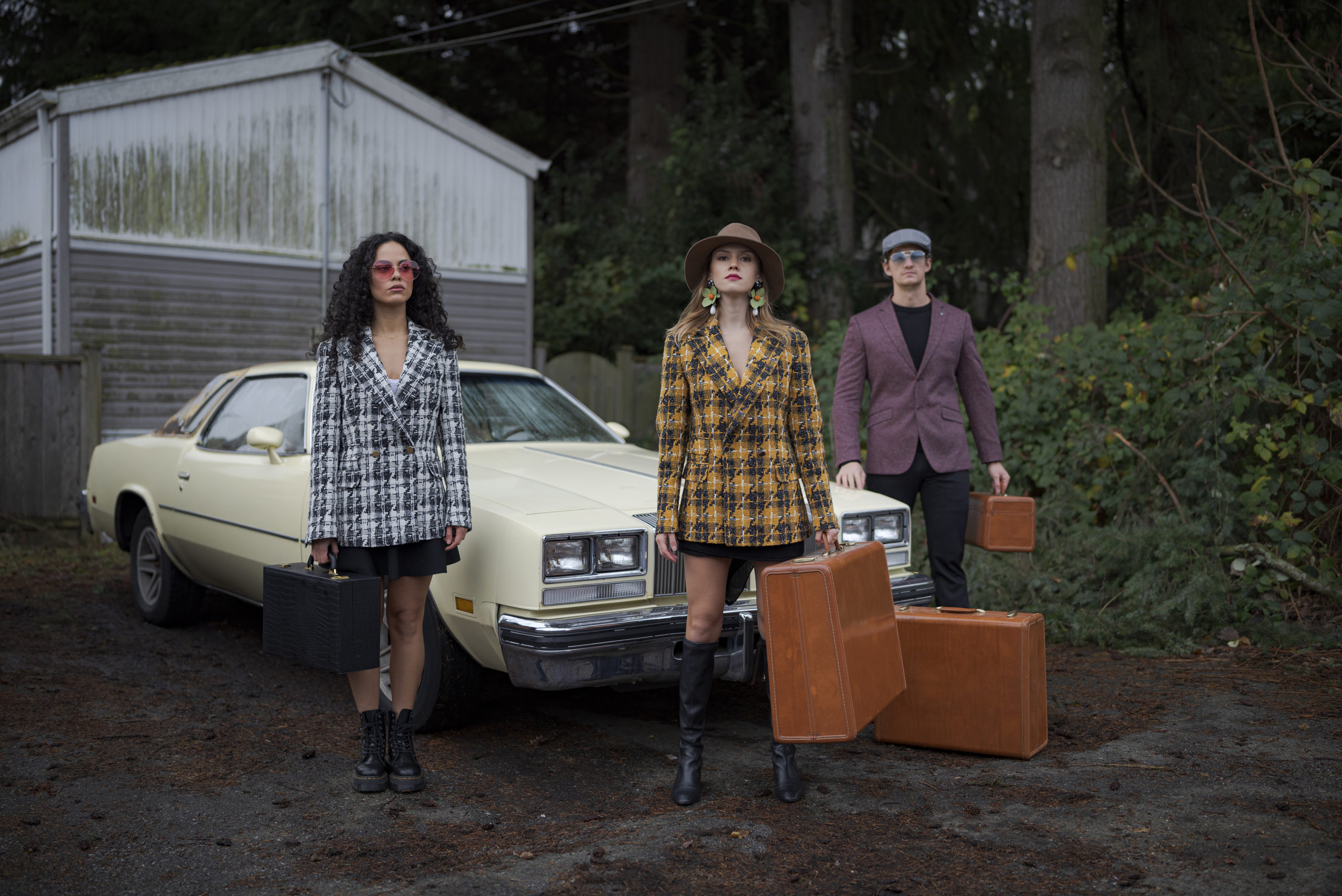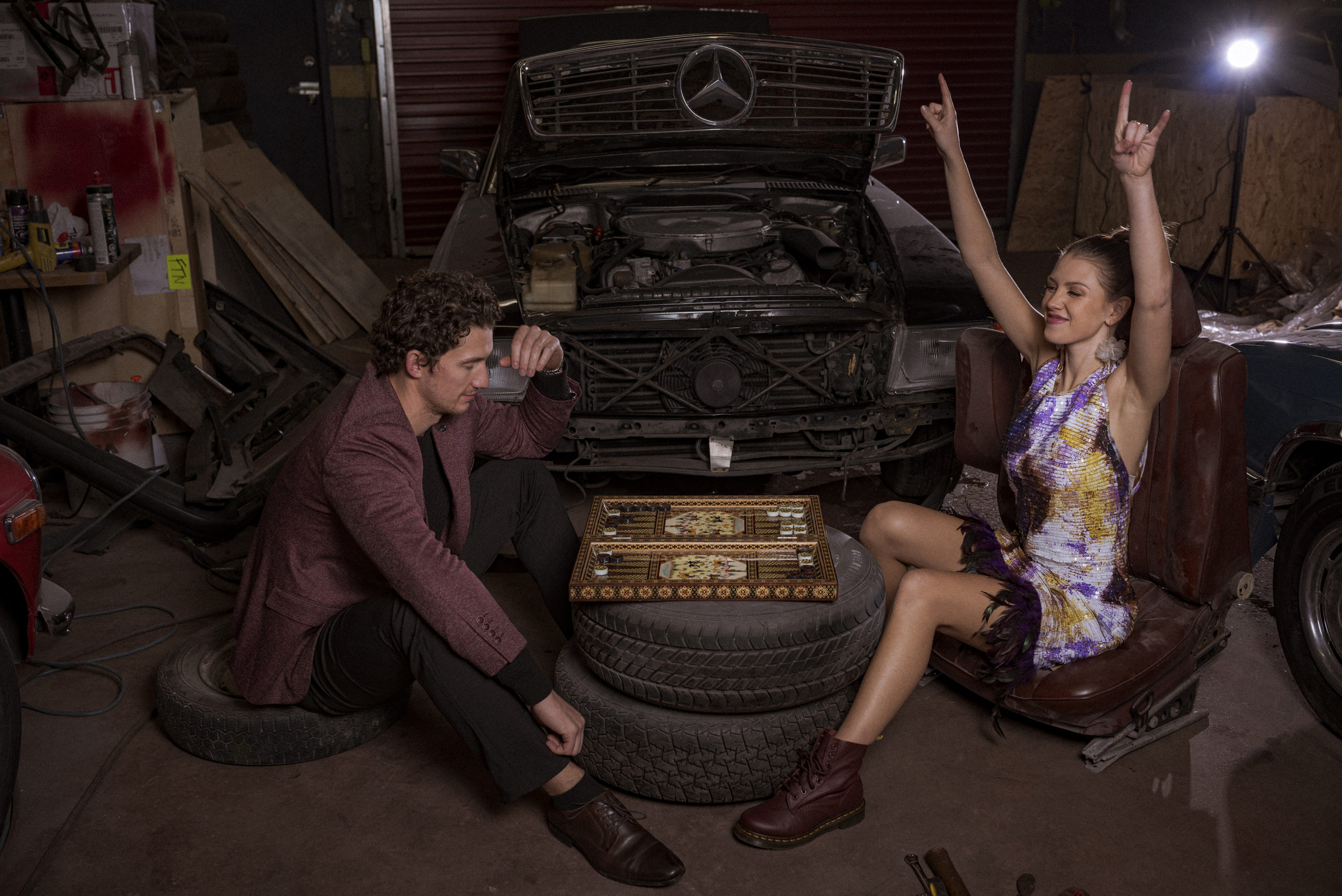
2020 left us all speechless. It’s crazy to think about how many incidents can happen in almost 12 months, but this year was one big roller coaster ride. We faced many world-changing events that caused an unusual uncertainty for individuals and organizations. The fashion industry certainly was no exception and was also affected by these alarming events. The majority of people think of the fashion industry as the razzle-dazzle of a catwalk. The fact is that the value of the fashion and apparel market is continually growing, making it one of the biggest industries worldwide.
“Revenue in the global Fashion segment is projected to reach US$665,629m in 2020. Revenue is expected to show an annual growth rate (CAGR 2020-2025) of 8.5%, resulting in a projected market volume of US$1,002,215m by 2025.” – statista.com

DRESS __ POUNEH ASKARIAN

JACKET __ SENATOR BESPOKE
LUGGAGE __ SENATOR BESPOKE
SHOES __ STYLIST’S OWN
Millennial Nostalgia
For the remainder of 2021 and going into 2022, here are a few changes to expect from the fashion industry: nostalgic fashion with a sense of belonging and comfort. This year is all about adjustments. Fashion also has to adjust to the new norms in this new era. Peoples’ attires are highly connected to their feelings and emotions. The interesting prospect for this year shows that the majority want to dress in a way that feels better instead of seeking the approval of others.
Nowadays, it’s all about casual, comfortable outfits. Sweatpants have made a total comeback in the fashion industry. Designer brands showcased upscale sweatsuits on the runways and every single catwalk. Hundreds of celebrities and influencers are showing off their styles, matching cool sweatpants with a designer blazer. In other words, the trend is to dress it up on the top and keeping it laid-back on the bottom. Denim and loungewear (pyjamas, robes, leggings) had huge growth in the apparel industry as well.
Something else has been impacted by the pandemic: We started to develop a new appreciation for our previous lives and we spent some time reflecting on the past. The forecasted trend seems to be inspired by nostalgia narratives. In other words, this is an unpredictable time for all of us so we want to see something nostalgic that brings us a sense of comfort, trust and acquaintance.
“The feeling of a lack of control is one of life’s biggest stressors. Because so much is out of our control at the moment and there is so much uncertainty, we resort to something that we can control, like our memories of the past,” explains behavioural psychologist and author of The Psychology Fashion, Carolyn Mair. “People have always looked back to the golden olden days because it makes us feel good to do so. We associate nostalgia with positive feelings and experiences, and we want to relive those feelings during times of upheaval.”

DRESS __ POUNEH ASKARIAN, INSTAGARM __ @POUNEHASKARIAN
SHOES __ STYLIST’S OWN

JACKETS __ SENATOR BESPOKE, AVAILABLE AT SENATORBESPOKE.COM
On a closer look, the fashion trend for this year is a shocker, just like 2020 itself. It is not simply a way of clothing or physical appearance, it is mostly connected with our minds and emotions. Brand strategists have one main objective: bringing us back great memories associated with old times. To create a new product line, they continuously analyse our past generations; what people have enjoyed or what they might have wanted but couldn’t get.
Social media is also promoting vintage and timelessness. Throwback Instagram accounts from the 60s, 70s and 90s boast millions of followers. They can visually celebrate vintage fashion by scrolling rare, old photographs from their favourite icons and celebrities.
“Whether it’s fashion publications or celebrities posting throwback images, nostalgic content comprises a big portion of what resonates with viewers these days,” says James, founder of Nineties Anxiety.
Nostalgic inspiration can arise anywhere from classic movies and old runway photographs to vintage magazines. We all take style inspirations from the past consciously or unconsciously, but in fashion trend forecasting, the notion of nostalgia seems to remain the world of fashion for years to come.


Data Forecasting & Digitization
The future of fashion is data-driven. Back in the days, fashion forecasters mainly considered economic influences, political movements, climate changes, and social media trends. Now, they use advanced data analysis to understand their customers’ patterns of purchase and closely observe their shopping behaviour. Gathering this valuable information will lead to products and designs that fulfill target market needs. Data helps brands to create innovative production methods and balance supply and demand. It benefits the fashion industry in sustainability. By efficiently producing pieces customers actually wear, manufacturers are reducing waste.
Consumers are now aware that fashion has long been one of the biggest contributors to waste and unsustainable production. Now they want their values reflected through their clothes, therefore they support smaller, sustainable labels and shop from brands that take a stand for the environment. In other words, we are noticing a rise of slow fashion and a decline of fast fashion which was popular for its ability to quickly produce numerous runway looks. Slow fashion is a movement of producing in lower quantities and using manufacturing with respect to people, the environment, and animals. It is also about companies being more transparent and using eco-friendly materials.
The future of fashion is also digital. This trend is not only limited to online shopping. Successful fashion brands are quickly adopting the latest digital technologies like AR and VR. They create a digital shopping experience by offering virtual showrooms, virtual fittings and sizing tools. A few brands also stepped further ahead by using 3D collections on avatar models. Using digital technologies brings an enormous amount of opportunity for the fashion industry. My favourite one is for designers to test out ideas virtually and float them with their team before actually creating the physical pieces.
Physical fashion shows and stores have a magical charm that cannot be replaced by online events and avatar models. But this year, the first-ever remote fashion week was a strong indicator that if you can’t implement the latest technology to your brand, your business may not stand the test of time.
In 2021, we have to be ready to see many changes in the fashion industry, from nostalgia trends to adopting the latest technologies, but also we’ll see a surge of slow fashion supporting sustainability.
By Pouneh Askarian

